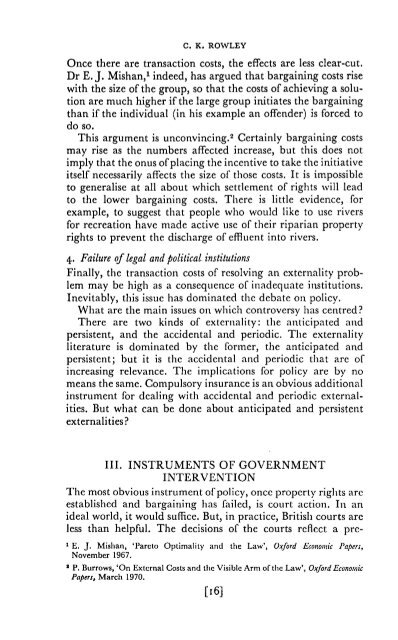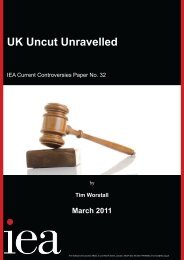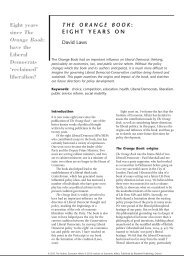THE MYTH OF SOCIAL COST.pdf - Institute of Economic Affairs
THE MYTH OF SOCIAL COST.pdf - Institute of Economic Affairs
THE MYTH OF SOCIAL COST.pdf - Institute of Economic Affairs
You also want an ePaper? Increase the reach of your titles
YUMPU automatically turns print PDFs into web optimized ePapers that Google loves.
C. K. ROWLEY<br />
Once there are transaction costs, the effects are less clear-cut.<br />
Dr E. J. Mishan, 1 indeed, has argued that bargaining costs rise<br />
with the size <strong>of</strong> the group, so that the costs <strong>of</strong> achieving a solution<br />
are much higher ifthe large group initiates the bargaining<br />
than if the individual (in his example an <strong>of</strong>fender) is forced to<br />
do so.<br />
This argument is unconvincing. 2 Certainly bargaining costs<br />
may rise as the numbers affected increase, but this does not<br />
imply that the onus <strong>of</strong> placing the incentive to take the initiative<br />
itself necessarily affects the size <strong>of</strong> those costs. It is impossible<br />
to generalise at all about which settlement <strong>of</strong> rights will lead<br />
to the lower bargaining costs. There is little evidence, for<br />
example, to suggest that people who would like to use rivers<br />
for recreation have made active use <strong>of</strong> their riparian property<br />
rights to prevent the discharge <strong>of</strong> effluent into rivers.<br />
4. Failure <strong>of</strong> legal and political institutions<br />
Finally, the transaction costs <strong>of</strong> resolving an externality problem<br />
may be high as a consequence <strong>of</strong> inadequate institutions.<br />
Inevitably, this issue has dominated the debate on policy.<br />
What are the main issues on which controversy has centred?<br />
There are two kinds <strong>of</strong> externality: the anticipated and<br />
persistent, and the accidental and periodic. The externality<br />
literature is dominated by the former, the anticipated and<br />
persistent; but it is the accidental and periodic that are <strong>of</strong><br />
increasing relevance. The implications for policy are by no<br />
means the same. Compulsory insurance is an obvious additional<br />
instrument for dealing with accidental and periodic externalities.<br />
But what can be done about anticipated and persistent<br />
externalities?<br />
III. INSTRUMENTS <strong>OF</strong> GOVERNMENT<br />
INTERVENTION<br />
The most obvious instrument <strong>of</strong> policy, once property rights arc<br />
established and bargaining has failed, is court action. In an<br />
ideal world, it would suffice. But, in practice, British courts are<br />
less than helpful. The decisions <strong>of</strong> the courts reflect a pre-<br />
1 E. J. Mishan, 'Pareto Optimality and the Law', Oxford <strong>Economic</strong> Papers,<br />
November 1967.<br />
* P. Burrows, 'On External Costs and the Visible Arm <strong>of</strong>the Law', Oxford <strong>Economic</strong><br />
Papers, March 1970.<br />
[16]












